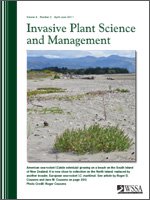Smooth brome (Bromus inermis) is an introduced, cool-season perennial, sod-forming grass that has been shown to invade both native cool-and warm-season grasslands throughout North America. During the fall of 2005 through spring 2007, we implemented a smooth brome removal study at five sites in eastern South Dakota. Sites were selected to represent a range of soil and environmental conditions. Seven fall herbicide treatments, five spring herbicide treatments, an untreated plot that was planted with a native seed mix, and an untreated control that received no herbicide or seed addition were applied at each location in fall 2005/spring 2006 and fall 2006/spring 2007. Based upon first-year results, three fall herbicide treatments and two spring herbicide treatments were added in fall 2006/spring 2007. Sites were seeded with a native plant mix within 2 wk following spring herbicide treatment. Smooth brome cover in untreated plots ranged from 73 to 99% at the conclusion of the study. Smooth brome cover on herbicide-treated plots ranged from 0 to 84% on 2005/2006 plots and 0 to 98% on 2006/2007 plots after three growing seasons. Native plant response varied by site and treatment, possibly due to competition from exotic weeds. Although several herbicides show promise for control of smooth brome, future response of native plants will be important in determining the proper timing and herbicide combination.
Nomenclature: Smooth brome, Bromus inermis Leyss. BROIN
Interpretive Summary: Smooth brome (Bromus inermis) is an introduced, cool-season perennial, sod-forming grass that has been widely planted as a forage species. However, it is also an aggressive grass that can rapidly invade native cool-and warm-season grasslands throughout North America. Much work has been devoted to developing management strategies for smooth brome. Many of the past studies utilized herbicides that are no longer labeled for use in certain situations, or required conversion of invaded areas to agriculture for several years prior to planting native species. New herbicides have the potential to allow direct conversion of smooth brome–dominated areas to native plant communities without prior conversion to agriculture. In this study we compared the efficacy of several herbicide combinations to control smooth brome, while allowing the establishment of planted native species. We also evaluated spring and fall application timings to determine if they have any significant effect (positive or negative) on smooth brome control, as well as native plant establishment. Several herbicide combinations show potential for controlling smooth brome and allowing establishment of planted native species. Treatments with sulfosulfuron glyphosate and imazapyr provided the most consistent smooth brome control during the study. Treatments that showed the greatest reduction in smooth brome also tended to have the highest cover of planted species. Caution still has to be exercised when using high rates of imazapyr, as it can cause injury to planted species. These results will allow managers to convert smooth brome–dominated fields to native plant communities without first converting them to agriculture, decreasing the amount of time necessary to achieve a successful conversion.





